THE CHI-TOWN HUSTLER
The most famous funny car of them all–the Farkonas, Coil and Minick ’69 Charger.
Story and photos by Paul Stenquist
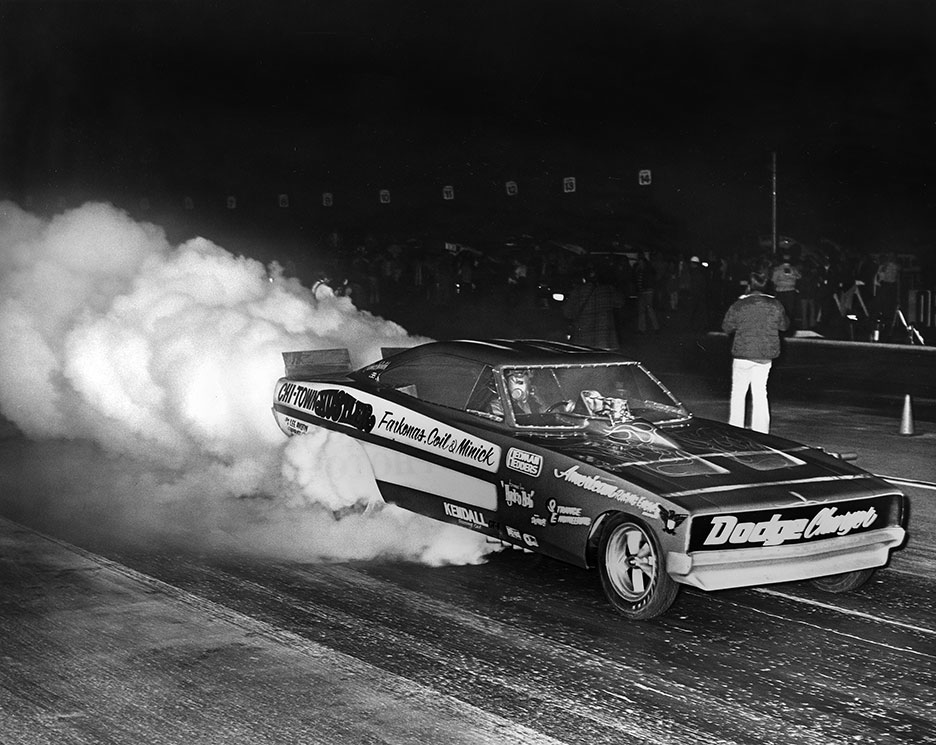
Drag racing’s most famous Hustler finally has a home. The ’69 Dodge Charger Chi-Town Hustler, which is without a doubt one of the most storied and most successful funny cars ever to put rubber to asphalt, is now a permanent part of Greg and Kathy Mosley’s Mopar collection. But for more than thirty years, the fabled Chi-Town flopper existed only in memories and faded photos. Now, thanks to Greg, Kathy, Pat Minick, and a host of others, that grand old funny car has been reincarnated in its entire unorthodox splendor. In fact, it’s come back as twins, but we’ll get to that later. First, let’s back up and see how this came to be.
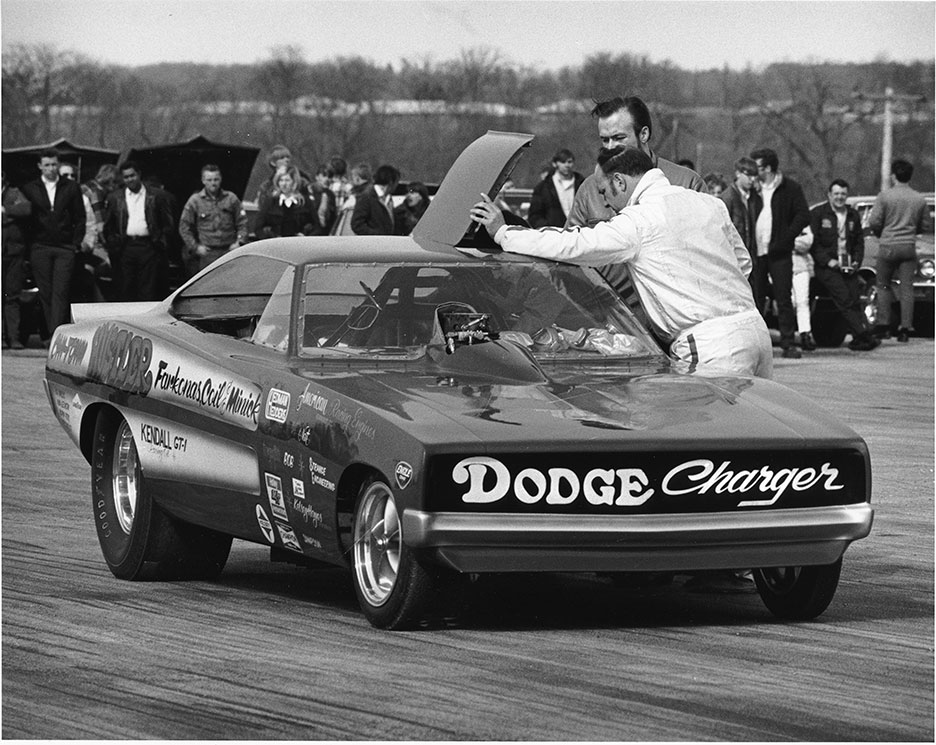
The ’69 Charger was the second flop from the Chicago trio of John Farkonas, Austin Coil and Pat Minick. All three racers had campaigned other cars before they officially became a team. Farkonas had campaigned a steel-bodied supercharged AA/FX ’65 Dodge match racer in 1966 with Minick at the wheel. Farkonas and Minick had previously run a Super Stock with the “Hustler” name on the rear quarter, and Coil had run a Super Stock car of his own. But the first FCM team effort was a hugely successful glass-bodied, tube-chassied ’67 Barracuda that hammered the Chi-Town Hustler name into drag-racing lore, winning first time out at the 1967 Funny Car Nationals in York, PA — a race that included nearly every big name in funny car racing. By the way, both the Barracuda and the “Farkonas Racing Enterprises” ’65 Dodge are lost somewhere in the smoky past. Minick has a reward for anyone who can locate either car.
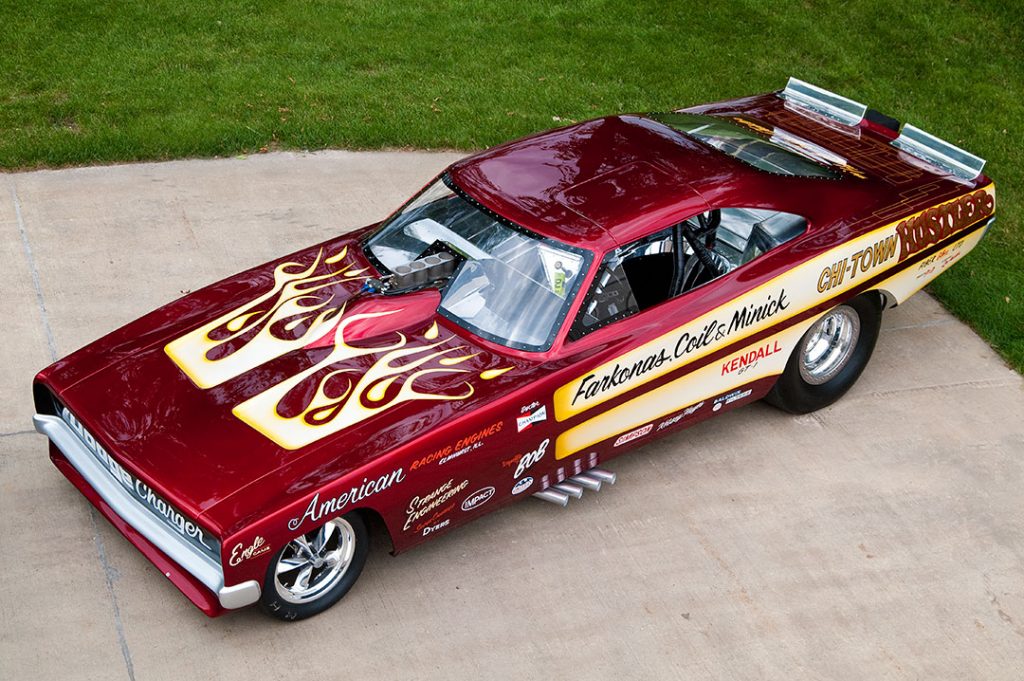
The gorgeous paint is identical to the original, but the quality is probably better, given today’s superior paint products. It was applied by Getz’s Hot Rod Innovations of Hampshire, Illinois. Rick Bendie did a good job duplicating the original lettering by Dexter, the iconic sixties sign painter.
In June of 1969, the Charger pictured here replaced the Barracuda. The chassis was a collaborative effort. Coil and Minick offered opinions, and Farkonas drafted a design. Then he constructed a chassis of toothpicks and tested it by applying a twisting force that approximated the forces generated by the engine and driven wheels. When a toothpick broke in the wrong place, the design was modified. Eventually, a brand new Chi-Town Hustler rolled out of the team’s little 1- ½ car garage on the south side of Chicago.
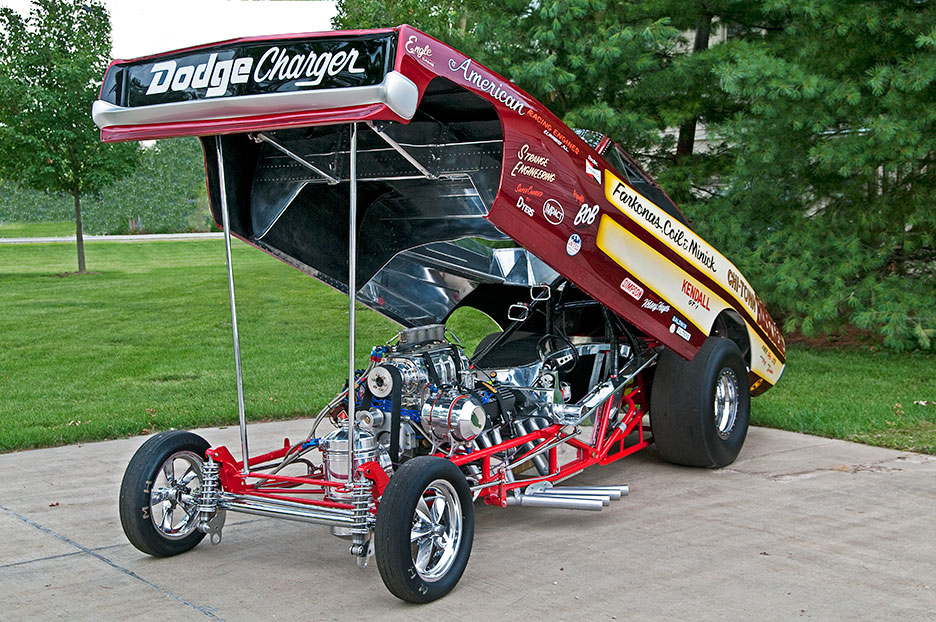
The body, which was crafted by Ron Pelligrini of Fiberglass Limited, was a miniature version of a Charger 500. The shrunken “Mini Charger” bodies were standard fare for Dodge funny cars of the day, but the new Chi-Town Hustler was unique in a number of other ways. First, the driver was positioned to the left, as in a passenger car. The engine was offset to the right to maintain balance. That gave driver Minick a great view of the track, but it also enabled a low-mounted, aerodynamic body, since the driver wasn’t sitting atop the drivetrain, and the roll cage didn’t have to be as tall as that of other funny cars.
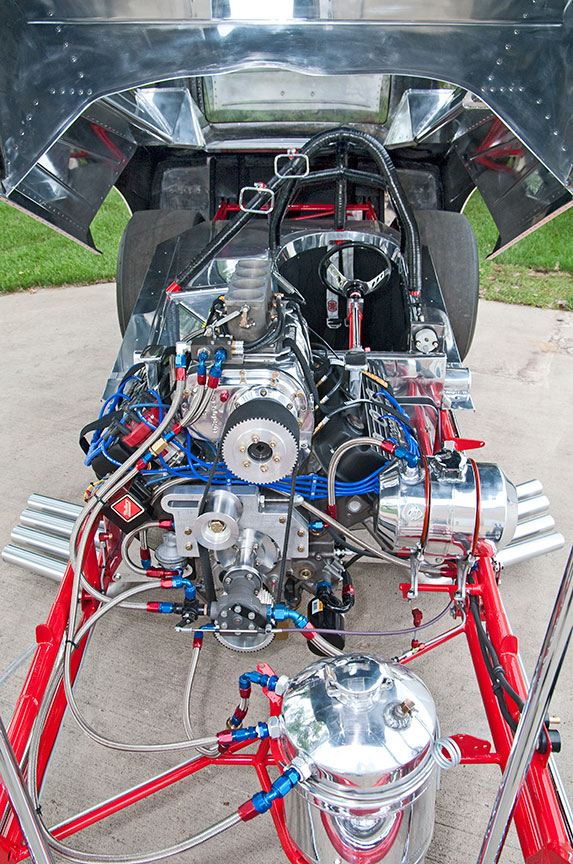
The honking Hemi under the glass was another story. Most supercharged fuel motors of the time ran a compression ratio of around 6:1 with about 25% huffer overdrive. But the Coil-tuned Chi-Town motor was built with 7:1 squeeze and 35% overdrive. The fuel mix was 80% nitro — as stout as possible given the fuel pumps of the day, and a far more potent sauce than what other racers were running.
On its first few passes, the car ran 7.30s at around 209 — approximately the same as the fastest cars of the time. Other racers were mildly impressed. They would have been speechless if they had known that Minick was lifting before shifting the Torqueflite. Without a pedal move, the impact of a gear change would have destroyed the input shaft. Bob Stange of Strange Engineering set to work making an input shaft of high-strength steel, and in July of 1969, Minick drove to the lights without lifting. The clock said 7.10, 207 mph. At the time, no funny car had ever run faster than 7.25.
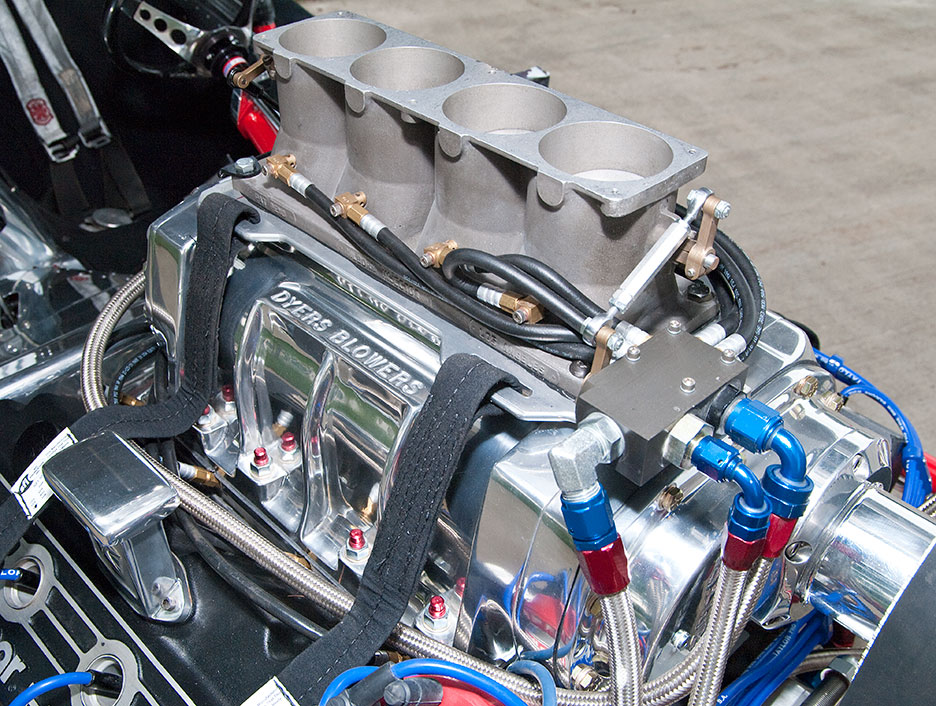
Getting bite at some of the tracks on which the match-racing Hustler ran was a problem, so rather than just doing a short burnout behind the starting line, Minick took to smoking the tires across the starting line. The fans loved it and before long, a burnout to half-track or more became part of the Hustler traveling funny car show. In September, the Hustler wrapped up the Midwest UDRA championship running a best of 7.02, 209. Second best was a 7.24.
Of course this all took place in the eastern half of the country, which was match-race heaven in those days. West-coast racers, who were pretty much stuck in the 7.20s, were skeptical and, as racers will do, insisted that the Hustler times were the result of hopped-up clocks.
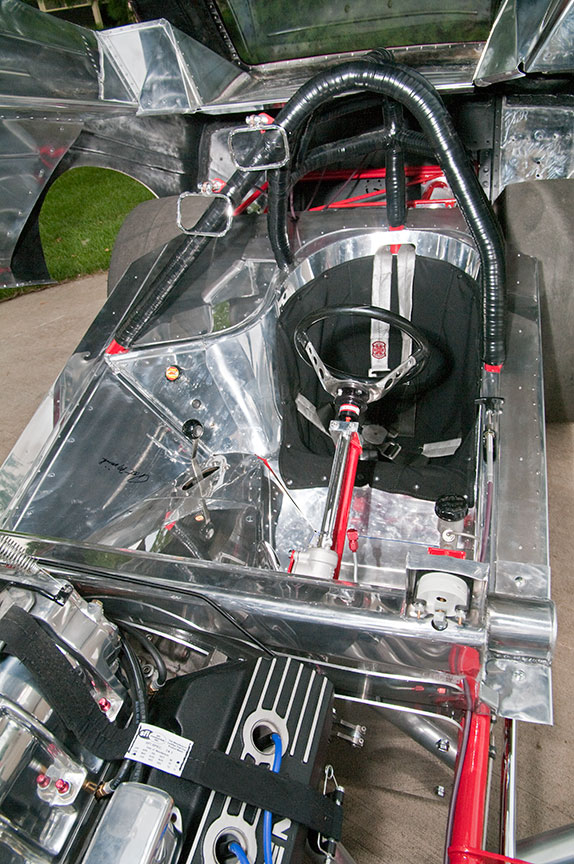
The Chi-Town gang put all doubts to rest with a winter west coast tour. It’s said that when they first unloaded the car at the old Lions dragstrip in Long Beach, Kenny Youngblood was watching. “You better load that thing back up and take it home,” he reportedly said. “We have honest clocks out here.”
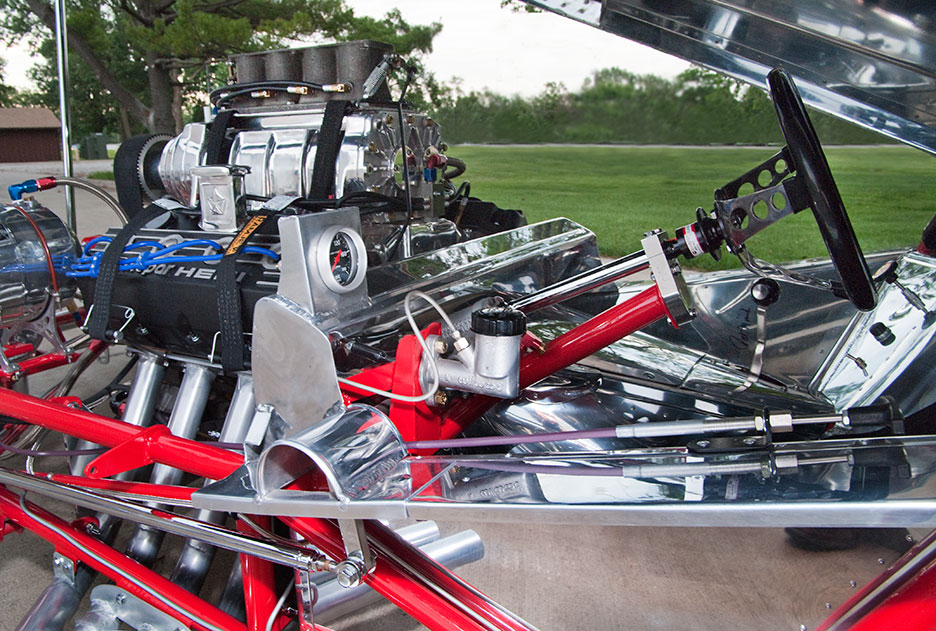
In 1970, it seemed like everyone was running a high compression, big-boost Hemi, and many were calling them “Coil Motors.” But the Hustler continued to dominate, setting 37 track records and winning numerous major events. It was one of the very first cars to run in the sixes, and the only funny car to run a six with a Torqueflite. (Some say the Hustler ran several sub-seven-second ETs on the match race circuit long before the first six-second pass was officially acknowledged, but that’s another story.)
By late 1971, the Charger was well worn and somewhat outdated. In August, a Challenger replaced the indomitable old Dodge and Minick retired from the driver’s seat. Minick became the team manager, and the Charger found a resting place under a tarp in his father’s backyard. Dad Minick wasn’t keen on living with the car, and it moved from yard to garage and back. Ultimately, it became a burden, and somewhere around 1973 it was sold to a Canadian track owner, who promised to use it only for displays.
Farkonas, Coil and Minick continued their winning ways with a number of different drivers in the hot seat of various Chi-Town Hustler funny cars. At least two of the cars that succeeded the ’69 Charger are in museums. The ’72 Challenger is in the NHRA museum in Pomona. A later version of the Hustler is in the Don Garlits museum.
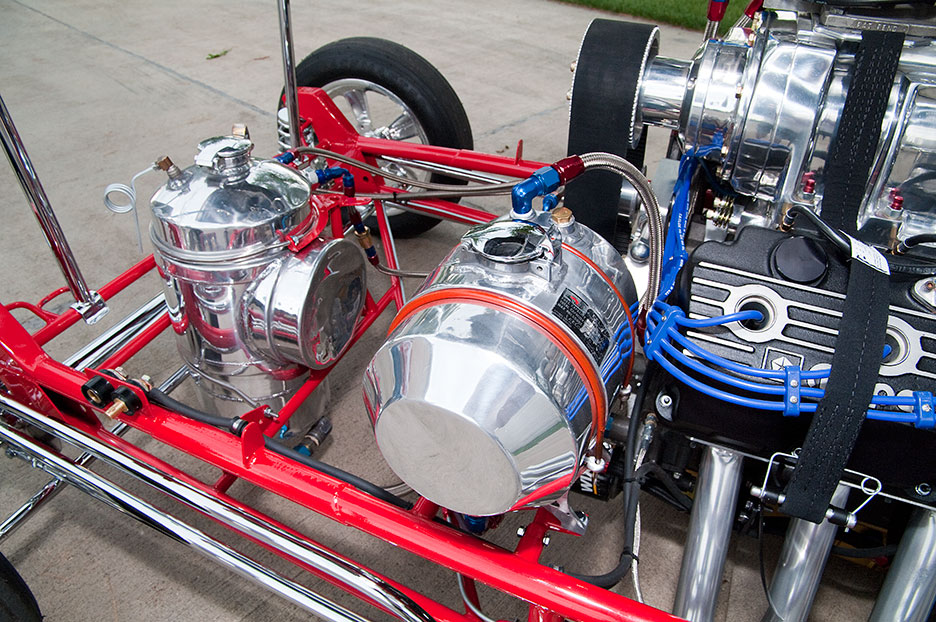
From the beginning the Chi-Town gang had shunned national event racing and appeared only with a cash guarantee. Their success and reputation made that policy a very lucrative one. However, the drag racing world evolved, and the Hustler gang eventually decided to forego their match-race-only policy and join the NHRA fray. When they made the leap, they did so in typical Hustler style, winning the NHRA world championship first time out with Frank Hawley at the wheel in 1982. They followed up with a repeat championship in ’83. But major sponsorship proved elusive, and Coil ultimately went to work for John Force, while Minick closed out the history of the Hustler with his son Wayne Minick in the driver’s seat.
Along the way, the mighty ’69 Charger — quite possibly the most successful car in funny car history — was all but forgotten.
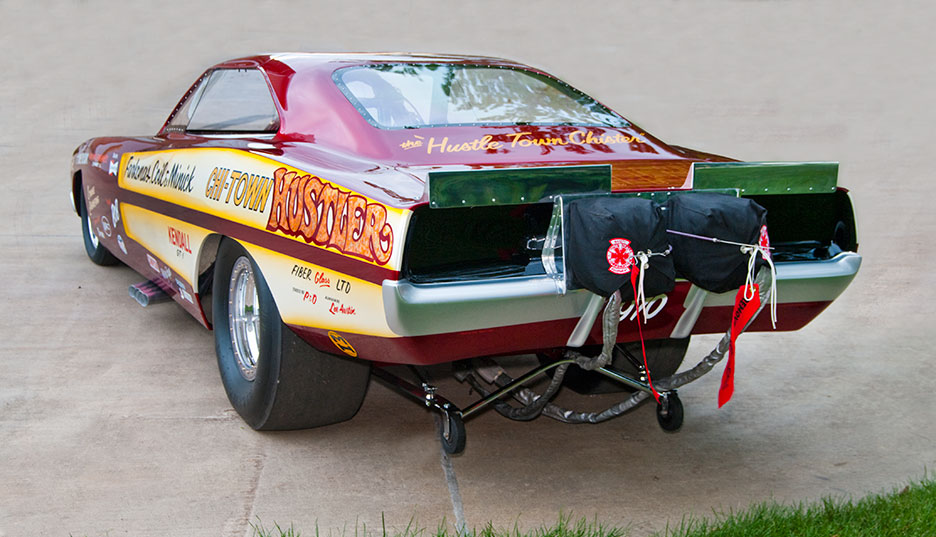
The rear window was flush with the C-pillars as on the Charger 500 cars. This was a more aerodynamic arrangement than the flying buttress C-pillars and recessed rear window of other Charger models. Rear deck sign painter went on to become a Mopar Action proofreader. The license plate says “1970.”. Like most funny racers of the time, the Chi-Town gang updated their car with impunity and the stroke of a paint brush.
In the 1990s, Minick was feeling nostalgic. What’s more, he wanted to go nostalgia racing with his son Wayne. So he put out the word that he was looking for the old warhorse. Somehow, word reached a guy up in Canada who had seen the ’69 Hustler run as a carbureted bracket racer. The car was soon purchased and brought back to Chicago.
“I wanted it to be safe to drive, so I hired a chassis builder to modernize it,” Minick says. “Perhaps that was a mistake, but it seemed like the right call at the time.” Thankfully, the work progressed very slowly. Very very slowly. The car sat unfinished for a number of years.
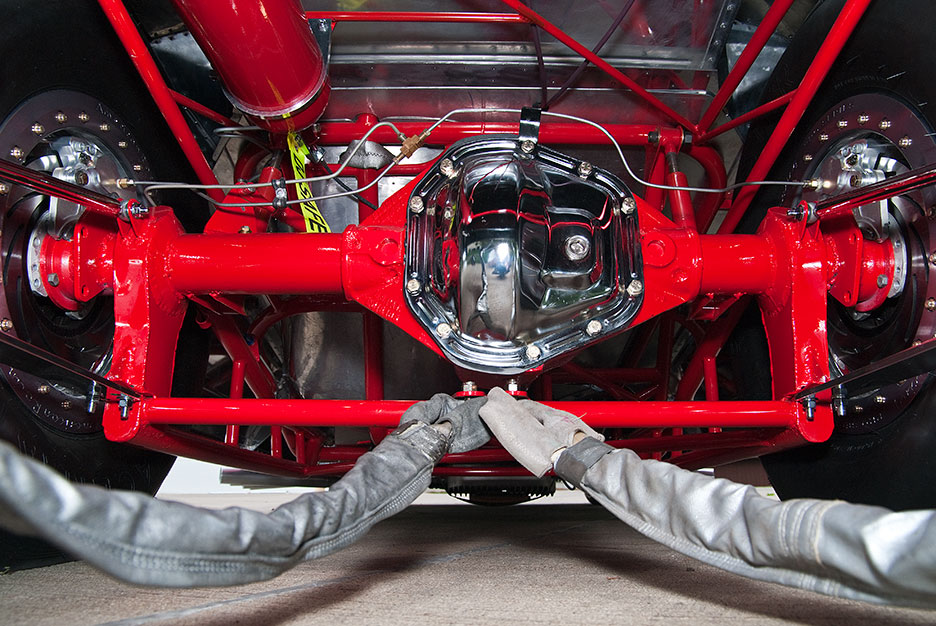
Meanwhile, Greg and Kathy Mosley and his wife had assembled quite a collection of race cars and rare Mopars for their private museum in Coal Valley, Illinois. Then, a few years ago, Mike Rachanski — son of automotive mogul Ed Rachanski — attended a race at Cordova. There he met Mosley’s neighbor Larry Griffith, the Super Stock hero who recently returned to the fray in a new Challenger. Larry took Ed down to Coal Valley to see the Mosley museum. Well, they got to talking about old times and Minick’s name came up. Mike mentioned that Minick had found the ’69 Charger. Greg’s eyes lit up.
Mosley and Minick had a couple of phone conversations regarding a possible sale. Pat and Wayne Minick traveled to Coal Valley a couple of times, inspected the premises, and interviewed the Mosleys. Apparently, Greg and Katy interviewed well, and a deal was done.
“Why did I buy it?” Greg ponders. “Hell, that’s easy. I remember it from back then. I remember the commercials on the radio: ‘Sunday, Sunday, Arnie the Farmer Beswick takes on Pat Minick in the amazing Chi-Town Hustler…’ In my opinion, the Hustler is the most famous funny car of all time. What an honor it is to have it in our museum, what a treat. My wife feels the same way. Do it, she said, and we did “
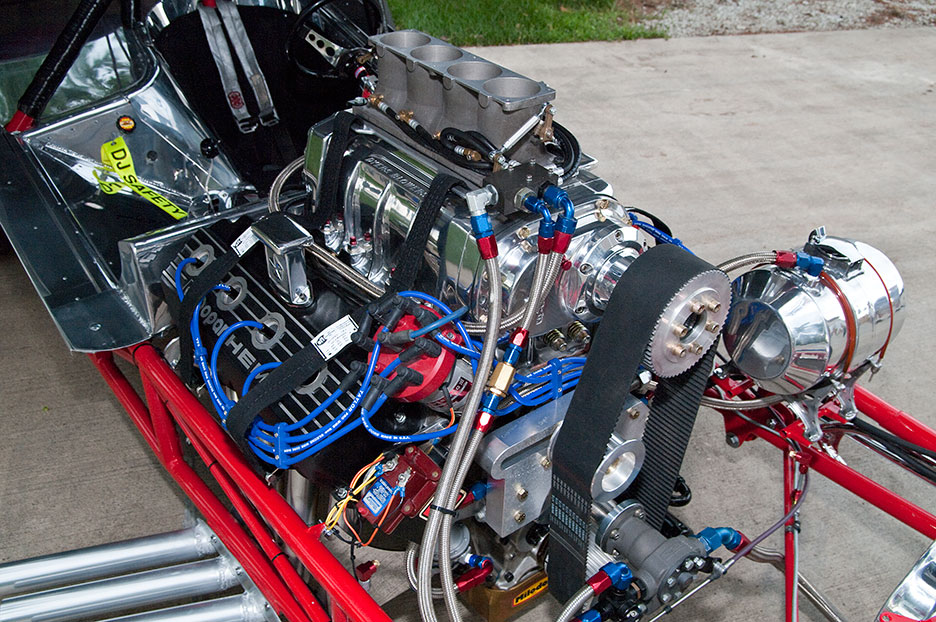
Not only did they do it, they did it in grand style, restoring the ’69 Charger so it looks almost exactly as it did the day it first rolled out of that little garage in old Chicago town. To ensure that it would never be tarnished or subject to the wear and tear of having to travel from its home, they built a clone of the car that will be used for shows and perhaps even nostalgia racing. It differs from the original in that it incorporates some changes that make it legal for competition. But at first glance, it’s a perfect twin.
“We’re just conservators…caretakers, that’s all,” Mosley muses, “We’re doing our part to keep drag racing legends alive. Revell, which has invested heavily to make a model of the ’69 Chi-Town Hustler is playing an important part in preserving the past as well. So is Mopar Action. You’re telling the story, keeping it alive. Don’t stop.”
Don’t worry Greg. We’re with you all the way.
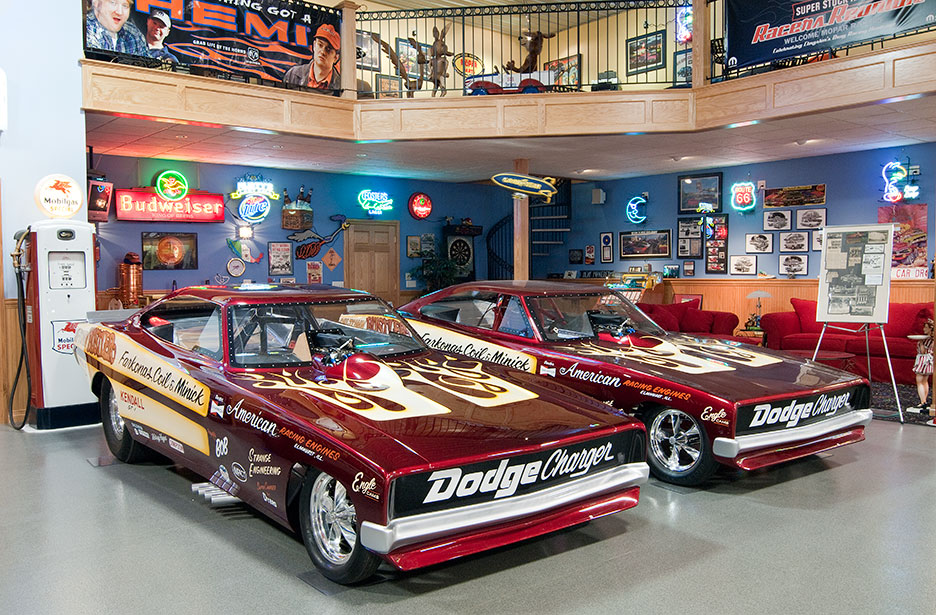


I grew up in the suburbs of Chicago when drag racing was a way of life for many people back in the 60s and 70s. Funny cars were all new and one piece fiberglass bodies were just coming in. I saw the Chitown Hustler and many others compete at Union Grove, US 30, Cordova and Byron. All were great pla cess to race. I think the most impressive was the 4 wides at Byron. Everyone else was making their burnouts and lastly came the Husler shaking the stands and smoking down the entire starting area. What a thrill for the… Read more »